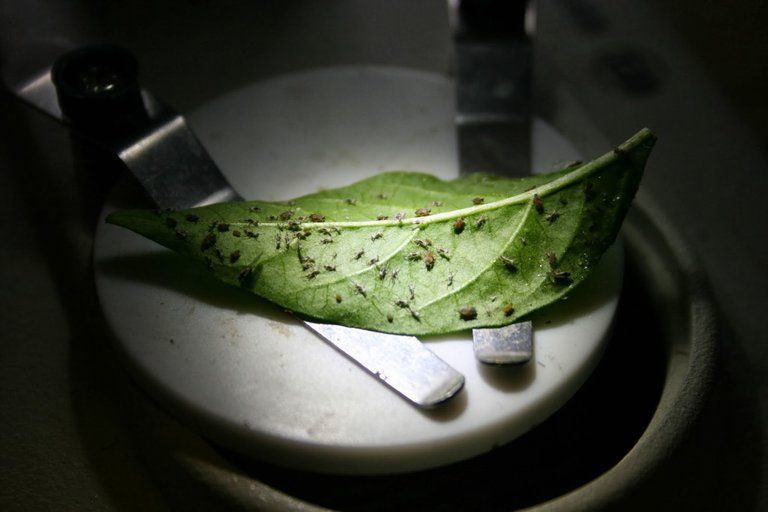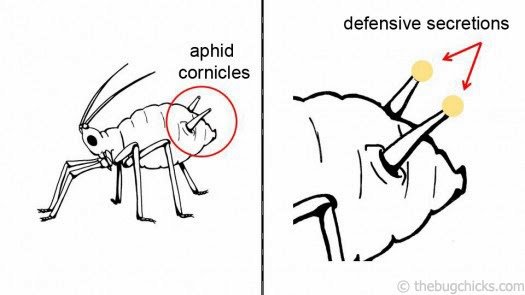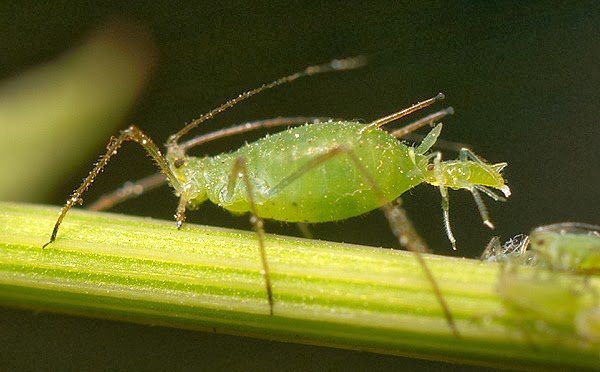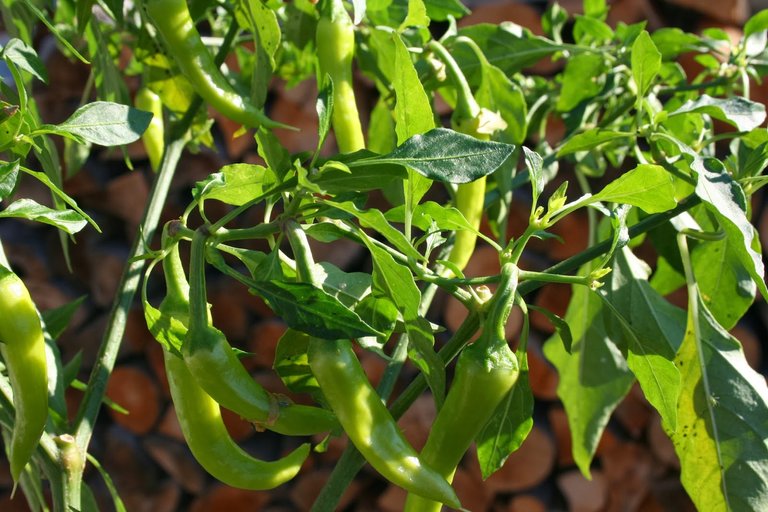Generally I live at ease with aphids in the garden. Occasionally they infest a bean plant but they are usually swiftly brought under control by the natural predators that roam the patch such as ladybirds, lacewings, hoverfly larvae and braconid/chalcid parasites before they do any lasting harm. They are also noticeably attracted to fresh apical growth of Prunus spp. such as cherry and peach, but soon come to the attention of a goldfinch that devours them over the course of a few sittings. However, in the greenhouse during the winter months, free from predation, they thrive and wreak havoc on the defenseless plants. My chilli pepper plants are the victims this year.

Leaf from Capsicum chinense inhabited by various generations of Aphis fabae subsp.
Having been away for Christmas for a few weeks I returned to find the pepper plants in a spot of bother. The aphid populations, well established on the plants, pierce the epidermis (plant skin) and suck the nutrient laden sap from the plants. The aphids do little visible harm and a healthy plant is able to cope with sharing some nutrients. However, aphid populations grow extremely fast and eventually they take their toll on the plant. Furthermore, the "honey dew" excreted as excess liquid by the aphids attracts sooty molds that feed on the excretions. As the mold grows, a greyish tissue blocks the plants ability to photosynthesize, thereby reducing its sustenance. Aphids are also vectors of many plant viruses - the aphids may not be the original source of infection but are instrumental in spreading the virus through a crop.
Eager to promote the healthy well being of the pepper plants I removed them from the greenhouse and set out to identify what aphid I was dealing with. There are about 4,400 species of 10 families known. My guys were brownish black and on closer inspection with a x10 microscope the cornicles (small horns on the rear) clearly visible on the abdomen suggested that the offenders are from the Aphididae family. Different aphid species generally target different plants. Pepper (Capsicum spp.) being from the Solanaceae family led me to believe that my guys are a sub specie of Aphis fabae aka blackfly. I am not certain, but it doesn't really matter in that the methods to control aphids remains the same for all species.

I set the aphid ridden plants on the kitchen table and after a while I noticed that the winged aphids had gathered in a warm corner of the kitchen window. As aphid populations grow and become crowded the females start to produce winged individuals that take to the air in order to find a fresh host plant, settle and begin to reproduce again.

Female aphid cloning herself.
The swarm of winged aphids on the window were, I assume, seeking new plants. Unfortunately for them they ended up a step closer to being mineralised. With winged aphids absent I took the plants outside (9C in January!!) and gave them a good shake. I know that heavy rains are known to significantly reduce aphid populations so I sprayed the plants with water using a pressurized hand sprayer and left them to bask in the sunshine. Aphids have a poor grip and cannot hang on very well and they will generally die before they can climb back onto the plant.
This seemed to do the trick for all but one of the most heavily infested plants. My son, eager to get his hands on the sprayer, repeated the showering over the next few days making sure to get the water on the underside of the leaves as this is where the aphids tend to congregate.

If the problem persists I'll try a simple anti-aphid spray I found on the web. Not sure how effective it is but here is the recipe.
Home made anti-aphid spray
Boil 5 large cloves of garlic and a teaspoon of cayenne pepper in a litre of water for 40 minutes. Strain it, and when cool use a mister bottle to spray it onto your plants.

Looking pepped up after the spray :)
Hi! I am a robot. I just upvoted you! I found similar content that readers might be interested in:
https://permies.com/t/31470/Anti-Aphid-chemical-compound-safe
very good
Thank you!
Great post!